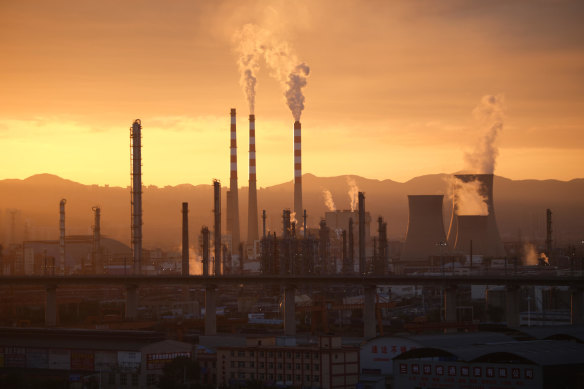Chief executive Mark Vassella said Chinese companies were flooding Asian markets with cheap steel as they tried to offload excess supply due to dried up domestic demand in China’s property sector.
“And what that’s done is that’s driven pressure on price, which then comes back to our domestic market here in Australia,” he told ABC TV’s The Business program last week.
Loading
Shares in Australia’s big iron ore miners have also plunged this year. Shares in BHP, the second-largest company on the Australian stock exchange, have fallen almost 20 per cent, Fortescue Metals shares have dropped almost 39 per cent this year, and Rio Tinto shares have slumped 18 per cent.
Many steel mills in China, the world’s biggest iron ore importer, have suffered from lacklustre demand and sinking product prices, and are cutting back on output. Research by Macquarie Bank found that 50 per cent of mills were said to be losing money, with a further 23 per cent just breaking even, while almost half planned to cut output either slightly or by a lot. Property remained the “main drag”, it said.
The impact of China’s economic slowdown is not just being felt in the commodity markets. Shares in a2 Milk, one of the largest suppliers of infant milk formula to China, plunged by more than 18 per cent on Monday after the New Zealand-based company released its 2023/24 results, and warned of a smaller than expected profit growth over the next year.
Though a2 Milk’s share of the Chinese market is increasing, chief executive David Bortolussi flagged the country’s declining birth rate as a longer-term challenge for the company’s growth along with increased competition from other suppliers in the market.
A2 milk on sale at an Alibaba run Smart supermarket in Hangzhou, China. Credit: Chris Crerara
In 2023, 9.02 million babies were born in China, half the number born in 2016. China’s shrinking population, which declined for the second straight year in 2023, falling by 2 million people, has major economic ramifications. It means fewer workers, fewer people buying homes, a decline in spending by consumers, and fewer people to support the country’s ageing population.
Dr Matthew Durban, a former Austrade senior economist and trade commissioner, says China’s economic slowdown is one of structural decline, not a cyclical one.
“I’m not going to sort of paint a rosy picture. I think the best we can hope for is a slowdown in growth. But I suspect this is a structural issue we’re going to have to get used to, and it will require adjustment of my profit margins, but also market diversification,” he says.
There is no question that China’s economy is in the doldrums after years of dazzling growth. It grew at a slower-than-forecast 4.7 per cent annual rate in the June quarter, below the government’s 5 per cent annual growth target as it struggles to convince Chinese consumers to splash their money around on retail goods.
Weak consumption – that is, Chinese people not spending enough, as households choose to squirrel away their savings – has been a problem that has plagued Beijing for years, says Dr Guonan Ma, an economist and senior fellow at the Asia Society Policy Institute.

The industrial skyline in Lanzhou, in western China in early August, shows its petrochemical industry is powering away. But a broader malaise in the Chinese economy is sending shockwaves into the Australian market. Credit: Sanghee Liu
“Beijing has pledged multiple times to try and do something about consumption, but each time they fail,” Ma says.
One such effort that experts say is unlikely to significantly boost consumption is a trade-in stimulus plan where consumers are offered subsidies for trading in old appliances like fridges and cars and buying new greener, more efficient models.
The consumption challenge is being exacerbated by the property market collapse, with people more reluctant to spend than ever before. At its peak in 2020, the real estate sector accounted for as much as 30 per cent of China’s GDP, while Chinese households had 80 per cent of their wealth tied up in property. The pain continued unabated last month as new home prices plunged at their fastest pace in nine years in July, falling 4.9 per cent from a year earlier.

A construction worker walks past a housing project under construction on the outskirts of Beijing, China, on Wednesday. There are millions of unsold, unfinished and vacant homes across China due to the property market collapse. Credit: AP
It is the sharpest drop in prices since June 2015, and comes despite the government’s efforts to rein in the freefall through a limited rescue package that involved reducing mortgage rates and lowering home buying costs.
The Chinese government’s plan for dragging the country out of its economic rut appears to be one adhering to a theme of continuity, not change.
Last month, the roughly 400 members of the Chinese Communist Party’s Central Committee, one of the party’s top governing bodies, gathered in Beijing for a multi-day meeting known as the third plenum. It is held roughly once every five years and is designed to set the country’s long term economic strategy.
Loading
For the most part, this year’s third plenum left many China watchers, analysts and investors underwhelmed but largely unsurprised. Far from charting a new policy direction to address some of the long term structural challenges, a resolution released after the meeting contained hundreds of proposed reforms that largely doubled down on Xi’s goal of “building a high-level socialist market economic system”, where the state is the key actor and the private sector a secondary player, and where national security objectives are intrinsically linked with modernisation goals.
There were no signs of a large-scale stimulus package in the works to boost domestic demand, or a major rescue effort for the property sector.
Earlier this month, Chinese authorities rejected a proposal by the International Monetary Fund to deploy the equivalent of $US1 trillion in central government funds to complete unfinished housing or compensate homebuyers.
Instead, a key plank of Xi’s economic plan is to shift China away from a property-heavy growth model to one powered by high-tech industries and advanced manufacturing in areas like EVs, solar panels, semiconductors, and AI.
Loading
Ma says China’s economic pain is set to linger for some time yet.
“The high-tech industry and renewable energy sector, are not big enough yet to replace the property sector as a major growth driver,” he says.
“Most likely, it will be a gradual and painful process, which could take a year or two before we see a floor,” he says.



















;Resize=(1180))

Discussion about this post